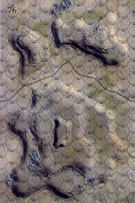|
|
|
Total |
| Side 1 |
0 |
| Draw |
0 |
| Side 2 |
0 |
|
Total |
| Side 1 |
0 |
| Draw |
0 |
| Side 2 |
0 |
|
Total |
| Side 1 |
0 |
| Draw |
0 |
| Side 2 |
0 |
|
| Overall Rating, 0 votes |
|---|
|
|
|
Scenario Rank:
--- of 940 |
| Parent Game |
An Army at Dawn 2nd Ed |
| Historicity |
Historical |
| Date |
1943-02-19 |
| Start Time |
09:30 |
| Turn Count |
12 |
| Visibility |
Day |
| Counters |
52 |
| Net Morale |
1 |
| Net Initiative |
1 |
| Maps |
1: 76 |
| Layout Dimensions |
43 x 28 cm
17 x 11 in |
| Play Bounty |
221 |
| AAR Bounty |
227 |
| Total Plays |
0 |
| Total AARs |
0 |
|
Introduction
|
|
The Italian supreme command had not yet accepted Rommel's plan to attack in northern Tunisia when the field marshal sent his troops forward. Rommel considered that every iteration of the plan included an attack at Kasserine, and Commando Supremo had indicated that an attack would be approved. Kasserine Pass offered serious advantages to the defender but it lay close by the forward German positions and appeared not too well guarded. Before contesting the pass itself Djebel Semmama needed to be subdued. At 0930 the Americans saw the Germans step off toward their perch.
|
|
Conclusion
|
|
The German infantry managed to wrestle most of the eastern slope from the Americans of Task Force Stark. However, a tenacious defense of the rest of the hilltop kept the Americans on the summit at the end of the day. Stark certainly could have used the troops, tanks and artillery thrown away by Fredendall’s foolish deployment at Feriana two days previously.
|
|
Additional Notes
|
|
Update of 1st edition scenario 30. |
Display Relevant AFV Rules
| AFV Rules Pertaining to this Scenario's Order of Battle |
- Vulnerable to results on the Assault Combat Chart (7.25, 7.63, ACC), and may be attacked by Anti-Tank fire (11.2, DFT). Anti-Tank fire only affects the individual unit fired upon (7.62, 11.0).
- AFV's are activated by tank leaders (3.2, 3.3, 5.42, 6.8).
They may also be activated as part of an initial activating stack, but if activated in this way would need a tank
leader in order to carry out combat movement.
- AFV's do not block Direct Fire (10.1).
- Full-strength AFV's with "armor efficiency" may make two anti-tank (AT) fire attacks per turn
(either in their action segment or during opportunity fire) if they have AT fire values of 0 or more
(11.2).
- Each unit with an AT fire value of 2 or more may fire at targets at a distance of between 100% and 150% of its
printed AT range. It does so at half its AT fire value. (11.3)
- Efficient and non-efficient AFV's may conduct two opportunity fires per turn if using direct fire
(7.44, 7.64).
Units with both Direct and AT Fire values may use either type of fire in the same turn as their opportunity fire,
but not both (7.22, 13.0).
Units which can take opportunity fire twice per turn do not have to target the same unit both times (13.0).
- Demoralized AFV's are not required to flee from units that do not have AT fire values (14.3).
- Place a Wreck marker when an AFV is eliminated in a bridge or town hex (16.3).
- AFV's do not benefit from Entrenchments (16.42).
- AFV's may Dig In (16.2).
- Closed-top AFV's: Immune to M, M1 and M2 results on Direct and Bombardment Fire Tables. Do not take step losses from Direct or Bombardment Fire. If X or #X result on Fire Table, make M morale check instead (7.25, 7.41, 7.61, BT, DFT).
- Closed-top AFV's: Provide the +1 modifier on the Assault Table when combined with infantry. (Modifier only applies to Germans in all scenarios; Soviet Guards in scenarios taking place after 1942; Polish, US and Commonwealth in scenarios taking place after 1943.) (ACC)
- Tank: all are closed-top and provide the +1 Assault bonus, when applicable
|
United States Order of Battle
| 2 Errata Items |

|
The reduced direct fire value of the Heer HMG became 5-5 starting with Fall of France.
|

|
The morale and combat modifiers of German Sergeant #1614 should be "0", not "8".
|





 AAD2029
AAD2029 





















